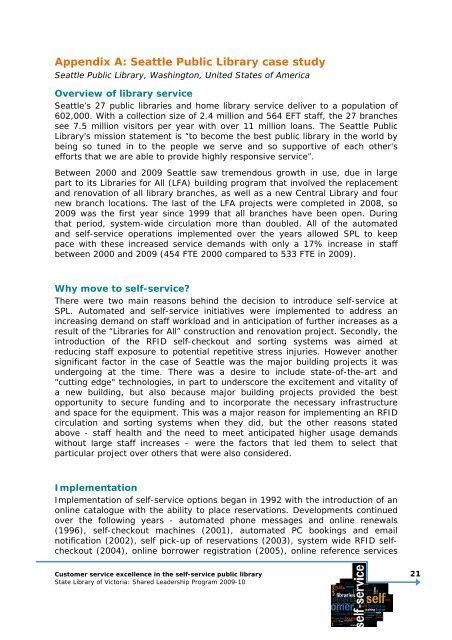Customer service excellence in the self-service public
Customer service excellence in the self-service public
Customer service excellence in the self-service public
You also want an ePaper? Increase the reach of your titles
YUMPU automatically turns print PDFs into web optimized ePapers that Google loves.
Appendix A: Seattle Public Library case study<br />
Seattle Public Library, Wash<strong>in</strong>gton, United States of America<br />
Overview of library <strong>service</strong><br />
Seattle’s 27 <strong>public</strong> libraries and home library <strong>service</strong> deliver to a population of<br />
602,000. With a collection size of 2.4 million and 564 EFT staff, <strong>the</strong> 27 branches<br />
see 7.5 million visitors per year with over 11 million loans. The Seattle Public<br />
Library's mission statement is “to become <strong>the</strong> best <strong>public</strong> library <strong>in</strong> <strong>the</strong> world by<br />
be<strong>in</strong>g so tuned <strong>in</strong> to <strong>the</strong> people we serve and so supportive of each o<strong>the</strong>r's<br />
efforts that we are able to provide highly responsive <strong>service</strong>”.<br />
Between 2000 and 2009 Seattle saw tremendous growth <strong>in</strong> use, due <strong>in</strong> large<br />
part to its Libraries for All (LFA) build<strong>in</strong>g program that <strong>in</strong>volved <strong>the</strong> replacement<br />
and renovation of all library branches, as well as a new Central Library and four<br />
new branch locations. The last of <strong>the</strong> LFA projects were completed <strong>in</strong> 2008, so<br />
2009 was <strong>the</strong> first year s<strong>in</strong>ce 1999 that all branches have been open. Dur<strong>in</strong>g<br />
that period, system-wide circulation more than doubled. All of <strong>the</strong> automated<br />
and <strong>self</strong>-<strong>service</strong> operations implemented over <strong>the</strong> years allowed SPL to keep<br />
pace with <strong>the</strong>se <strong>in</strong>creased <strong>service</strong> demands with only a 17% <strong>in</strong>crease <strong>in</strong> staff<br />
between 2000 and 2009 (454 FTE 2000 compared to 533 FTE <strong>in</strong> 2009).<br />
Why move to <strong>self</strong>-<strong>service</strong>?<br />
There were two ma<strong>in</strong> reasons beh<strong>in</strong>d <strong>the</strong> decision to <strong>in</strong>troduce <strong>self</strong>-<strong>service</strong> at<br />
SPL. Automated and <strong>self</strong>-<strong>service</strong> <strong>in</strong>itiatives were implemented to address an<br />
<strong>in</strong>creas<strong>in</strong>g demand on staff workload and <strong>in</strong> anticipation of fur<strong>the</strong>r <strong>in</strong>creases as a<br />
result of <strong>the</strong> “Libraries for All” construction and renovation project. Secondly, <strong>the</strong><br />
<strong>in</strong>troduction of <strong>the</strong> RFID <strong>self</strong>-checkout and sort<strong>in</strong>g systems was aimed at<br />
reduc<strong>in</strong>g staff exposure to potential repetitive stress <strong>in</strong>juries. However ano<strong>the</strong>r<br />
significant factor <strong>in</strong> <strong>the</strong> case of Seattle was <strong>the</strong> major build<strong>in</strong>g projects it was<br />
undergo<strong>in</strong>g at <strong>the</strong> time. There was a desire to <strong>in</strong>clude state-of-<strong>the</strong>-art and<br />
"cutt<strong>in</strong>g edge" technologies, <strong>in</strong> part to underscore <strong>the</strong> excitement and vitality of<br />
a new build<strong>in</strong>g, but also because major build<strong>in</strong>g projects provided <strong>the</strong> best<br />
opportunity to secure fund<strong>in</strong>g and to <strong>in</strong>corporate <strong>the</strong> necessary <strong>in</strong>frastructure<br />
and space for <strong>the</strong> equipment. This was a major reason for implement<strong>in</strong>g an RFID<br />
circulation and sort<strong>in</strong>g systems when <strong>the</strong>y did, but <strong>the</strong> o<strong>the</strong>r reasons stated<br />
above - staff health and <strong>the</strong> need to meet anticipated higher usage demands<br />
without large staff <strong>in</strong>creases – were <strong>the</strong> factors that led <strong>the</strong>m to select that<br />
particular project over o<strong>the</strong>rs that were also considered.<br />
Implementation<br />
Implementation of <strong>self</strong>-<strong>service</strong> options began <strong>in</strong> 1992 with <strong>the</strong> <strong>in</strong>troduction of an<br />
onl<strong>in</strong>e catalogue with <strong>the</strong> ability to place reservations. Developments cont<strong>in</strong>ued<br />
over <strong>the</strong> follow<strong>in</strong>g years - automated phone messages and onl<strong>in</strong>e renewals<br />
(1996), <strong>self</strong>-checkout mach<strong>in</strong>es (2001), automated PC book<strong>in</strong>gs and email<br />
notification (2002), <strong>self</strong> pick-up of reservations (2003), system wide RFID <strong>self</strong>-<br />
checkout (2004), onl<strong>in</strong>e borrower registration (2005), onl<strong>in</strong>e reference <strong>service</strong>s<br />
<strong>Customer</strong> <strong>service</strong> <strong>excellence</strong> <strong>in</strong> <strong>the</strong> <strong>self</strong>-<strong>service</strong> <strong>public</strong> library 21<br />
State Library of Victoria: Shared Leadership Program 2009-10






